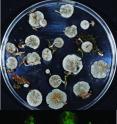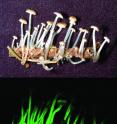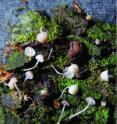7 new luminescent mushroom species discovered
Related images
(click to enlarge)
Seven new glow-in-the-dark mushroom species have been discovered, increasing the number of known luminescent fungi species from 64 to 71. Reported today in the journal Mycologia, the new finds include two new species named after movements in Mozart's Requiem. The discoveries also shed light on the evolution of luminescence, adding to the number of known lineages in the fungi 'family tree' where luminescence has been reported. San Francisco State University Biology Professor Dennis Desjardin and colleagues discovered the fungi in Belize, Brazil, Dominican Republic, Jamaica, Japan, Malaysia and Puerto Rico. The discoveries include four species new to science and three new reports of luminescence in known species. Three quarters of glowing mushrooms, including the species described in the study, belong to the Mycena genus, a group of mushrooms that feed off and decompose organic matter as a source of nutrients to sustain their growth.
"What interests us is that within Mycena, the luminescent species come from 16 different lineages, which suggests that luminescence evolved at a single point and some species later lost the ability to glow," said Desjardin, lead author of the study. He believes that some fungi glow in order to attract nocturnal animals that aid in the dispersal of the mushroom's spores which are similar to seeds and are capable of growing into new organisms.
"It's pretty unusual to find this many luminescent species, typically only two to five percent of the species we collect in the field glow," Desjardin said. "I'm certain there are more out there."
The newly discovered fungi glow constantly, emitting a bright, yellowish-green light, and are tiny, with caps smaller than one centimeter across.
Desjardin has named two of the new species Mycena luxaeterna (eternal light) and Mycena luxperpetua (perpetual light), names inspired by Mozart's Requiem and the fact that these mushrooms glow 24 hours a day. To date, Desjardin has discovered more than 200 new fungi species and together with these latest findings, has discovered nearly a quarter of all known luminescent fungi.
Source: San Francisco State University
Other sources
- 7 new luminescent mushroom species discoveredfrom Biology News NetTue, 6 Oct 2009, 2:42:08 UTC
- GLOWING MUSHROOM PICTURES: Psychedelic New Species Seenfrom National GeographicMon, 5 Oct 2009, 23:21:04 UTC
- Flashy Fungi: Researchers Still in the Dark over Glowing Jungle Mushroomsfrom Scientific AmericanMon, 5 Oct 2009, 19:42:09 UTC
- Seven New Luminescent Mushroom Species Discoveredfrom Science DailyMon, 5 Oct 2009, 17:35:31 UTC
- Glow-in-the-dark mushrooms discoveredfrom MSNBC: ScienceMon, 5 Oct 2009, 17:21:55 UTC
- Seven new luminescent mushroom species discoveredfrom PhysorgMon, 5 Oct 2009, 17:21:31 UTC


